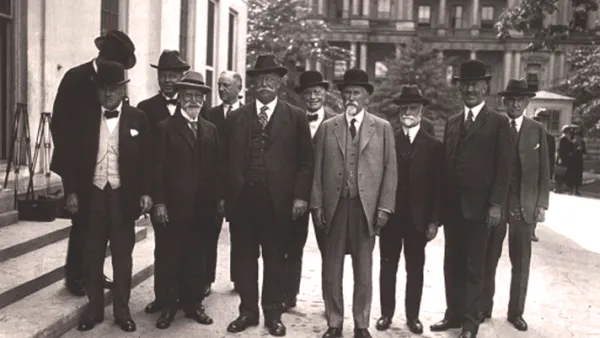The Judicial Conference of the United States is the national policymaking body for the federal courts.
The Judicial Conference convenes twice a year to consider administrative and policy issues affecting the federal court system, and to make recommendations to Congress concerning legislation involving the Judicial Branch. Learn more about:
Reports of the Proceedings
Read summary reports issued following sessions of the Judicial Conference dating back to its origin. The proceedings detail actions taken, who was present at the session, and other information.
Membership
The Chief Justice of the United States is the presiding officer of the Judicial Conference. Membership is comprised of the chief judge of each judicial circuit, the Chief Judge of the Court of International Trade, and a district judge from each regional judicial circuit.
A circuit chief judge's term on the Conference is concurrent with his or her term as chief judge of the circuit. With limited exceptions, 28 U.S.C. § 45(a)(1)b provides that a circuit’s chief judge may serve for seven years or until attaining the age of seventy, whichever comes first. Similar provisions apply to the Chief Judge of the Court of International Trade. See 28 U.S.C. § 258.
District judge representatives are elected for terms of not less than three nor more than five successive years, as established by majority vote of all circuit and district judges of the circuit (28 U.S.C. § 331). By Conference policy, terms begin and end on Oct. 1 of any given year.
- October 2024 Members (PDF)
Organization
The Executive Committee of the Judicial Conference serves as the senior executive arm of the Conference, acting on its behalf between sessions on matters requiring emergency action as authorized by the Chief Justice; the Executive Committee is not otherwise a policymaking committee of the Judicial Conference.
The Director of the Administrative Office of the U.S. Courts (AO) serves as Secretary to the Judicial Conference and is an ex-officio member of the Executive Committee. The AO Director coordinates administrative support to the Conference itself and the Executive Committee. The AO Director also coordinates the activities of AO professional staff who dedicate all or much of their time supporting the work of the Judicial Conference and its committees.
Judicial Conference Committees
The Conference operates through a network of committees. These committees focus on specific topics such as information technology, human resources, probation and pretrial services, space and facilities, security, budget, defender services, court administration, rules of practice and procedure, and magistrate and bankruptcy judge matters. The Chief Justice has sole authority to make committee appointments.
Judicial Conference committees review issues within their established jurisdictions and make policy recommendations to the Conference. The committees are policy-advisory entities and are not involved in making day-to-day management decisions for the federal courts or for the Administrative Office. Judicial Conference committees derive their jurisdiction from the Conference itself and the Chief Justice as presiding officer.
Matters Before Committees
In addition to reviewing issues within their established jurisdictions, Conference committees may also study relevant matters requested by the Chief Justice of the United States, the Executive Committee, the Conference Secretary (AO Director), Congress, federal judges, circuit judicial councils, and other Conference committees, or as required by statute.
Requests for consideration of items by the Judicial Conference or one of its committees should be directed to the AO Director.
List of Committees
- The Executive Committee
- Committee on Audits and Administrative Office Accountability
- Committee on the Administration of the Bankruptcy System
- Committee on the Budget
- Committee on Codes of Conduct
- Committee on Court Administration and Case Management
- Committee on Criminal Law
- Committee on Defender Services
- Committee on Federal-State Jurisdiction
- Committee on Financial Disclosure
- Committee on Information Technology
- Committee on Intercircuit Assignments
- Committee on International Judicial Relations
- Committee on the Judicial Branch
- Committee on Judicial Conduct and Disability
- Committee on Judicial Resources
- Committee on Judicial Security
- Committee on the Administration of the Magistrate Judges System
- Committee on Rules of Practice and Procedure
- Advisory Committee on Appellate Rules
- Advisory Committee on Bankruptcy Rules
- Advisory Committee on Civil Rules
- Advisory Committee on Criminal Rules
- Advisory Committee on Evidence Rules
- Committee on Space and Facilities
History
Congress established the Conference of Senior Circuit Judges in 1922, at the urging of Chief Justice (and former President) William Howard Taft. In 1948, Congress renamed it the Judicial Conference of the United States.
In its earliest years, the Conference addressed rising caseloads caused by Prohibition, and established procedures for accurate, comprehensive statistics to measure court business. Over its first century, the Conference grappled with many issues, such as the need for additional judgeships, natural disasters, public-health crises, containing costs, changes in technology, and judicial security.
The Conference also has played a central role in improving efficient case management, reducing sentencing disparities, and overseeing changes to federal rules of practice and procedure.
- View a historical timeline of major Judicial Conference milestones.
- Read news articles that take a look back at how the Judiciary’s national policy making body has grappled with many issues to mark the 100th anniversary.
- Read an archival federal court newsletter (PDF) recounting the 75th anniversary of the Judicial Conference.
Historical Timeline
View a timeline of Judicial Conference milestones throughout the last century.

